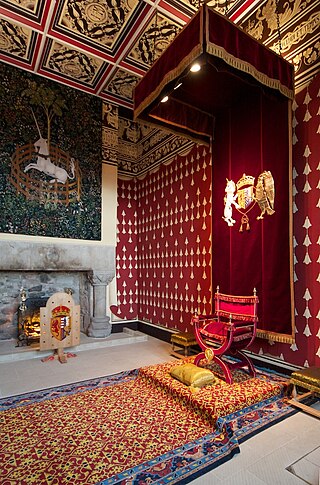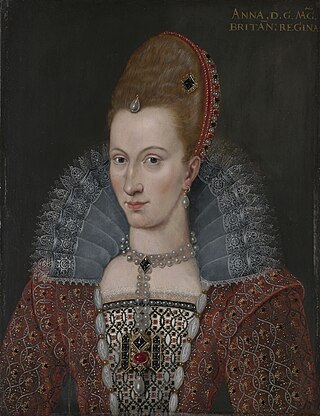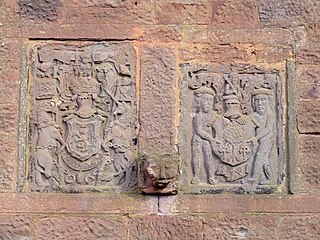Helen Guthrie (fl. 1592) was a Scottish petitioner. [1]
Contents

Helen Guthrie (fl. 1592) was a Scottish petitioner. [1]

Helen Guthrie was the daughter of an Aberdeen saddle maker, John Guthrie. She is known for approaching James VI of Scotland in June 1592 and arguing with him that he should reform his rule and actions according to Presbyterian values. [2]
Guthrie approached the King in Edinburgh as he was about to set out hunting with his dogs. She seems to have made a speech and presented a written text, asking James VI to refrain from swearing and properly honour the Sabbath. It was not unusual for an ordinary subject in Scotland to approach the King in such a way. James is said to have laughed and sworn at her and asked if she was a prophetess. Helen described herself as a "simple servant of God". He sent her to his wife Anne of Denmark who treated her more kindly. [3]
The details of her meeting the king were collected by the historian David Calderwood and the text of her petition or admonition was preserved in a collection known as the Warrender Papers. The Warrender copy says that she was 18 years old. Calderwood felt her mind was "disquieted". Recent historians including Maureen Meikle note that the admonition is carefully composed. [4] The exact date of the incident is unknown, at the end of June 1592 James VI and Anne of Denmark were at Falkland Palace, and were briefly besieged by the Earl of Bothwell, before returning to Holyrood. [5]
James VI and Anne of Denmark had previously encountered a woman from Lübeck who claimed to bring a prophecy for the king in 1590. She was interviewed by a secretary at court, George Young. [6]

Agnes Sampson was a Scottish healer and purported witch. Also known as the "Wise Wife of Keith", Sampson was involved in the North Berwick witch trials in the later part of the sixteenth century.
Sir William Stewart of Houston was a Scottish soldier, politician and diplomat.
Sir John Carmichael was a Scottish soldier, the Keeper of Liddesdale, a diplomat, and owner of Fenton Tower at Kingston, East Lothian.
Robert Bowes (1535?–1597) was an English diplomat, stationed as permanent ambassador to Scotland from 1577 to 1583.

Sir Peter Young (1544–1628) was a Scottish diplomat, Master Almoner, and tutor to James VI of Scotland.
Jean Fleming, Countess of Cassilis (1553/4–1609) was a Scottish noblewoman and courtier at the court of James VI of Scotland, and a survivor of domestic violence.
Barbara Napier or Naper was a Scottish woman involved in the 1591 North Berwick witch trials. Details of charges against her survive, and she was found guilty of consulting with witches, but it is unclear if, like the other accused people, she was executed.

John Wemyss younger of Logie, (1569-1596), was a Scottish courtier, spy, and subject of the ballad "The Laird o Logie", beheaded for plotting to blow up a fortification at Veere in the Netherlands

The masque at the baptism of Prince Henry was a celebration at the christening of Prince Henry at Stirling Castle, written by the Scottish poet William Fowler and Patrick Leslie, 1st Lord Lindores.

Margaret Vinstarr, was a Danish courtier in Scotland to Anne of Denmark commemorated by the ballad "The Laird o Logie" for rescuing her imprisoned lover.
George Young was a Scottish churchman, courtier, member of the Privy Council of Scotland, diplomat, and secretary depute.

Peder Munk of Estvadgård (1534–1623), was a Danish navigator, politician, and ambassador, who was in charge of the fleet carrying Anne of Denmark to Scotland. The events of the voyage led to witch trials and executions in Denmark and Scotland.

On 17 May 1590, Anne of Denmark was crowned Queen of Scotland. There was also a ceremony of joyous entry into Edinburgh on 19 May, an opportunity for spectacle and theatre and allegorical tableaux promoting civic and national identities, similar in many respects to those performed in many other European towns. Celebrations for the arrival of Anne of Denmark in Scotland had been planned and prepared for September 1589, when it was expected she would sail from Denmark with the admirals Peder Munk and Henrik Gyldenstierne. She was delayed by accidents and poor weather and James VI of Scotland joined her in Norway in November. They returned to Scotland in May 1590.
Sir James Sandilands was a courtier to King James VI and I and captain of Blackness Castle
Elizabeth Stewart, Countess of Arran was a Scottish aristocrat and political intriguer. Several accounts of her actions and ambition were written by her political enemies.
Maureen M. Meikle is an academic historian.
John Kinloch or Killoch was keeper of the royal tennis courts, a post master and stable owner in 16th-century Edinburgh and the proprietor of house used for lodgings and banquets.

The Raid of Holyrood was an attack on Holyrood Palace, Edinburgh on 27 December 1591 by Francis Stewart, 5th Earl of Bothwell in order to gain the favour of King James VI of Scotland. Bothwell subsequently staged a raid at Falkland Palace, and in July 1593 made another attempt at Holyrood.

Margaret Wood was a Scottish Catholic courtier. She was a daughter of Patrick Wood, Laird of Bonnyton and Nicholas Wardlaw, Lady Bonnyton, who was a daughter of Henry Wardlaw of Torrie and a former lady in waiting to Mary, Queen of Scots.

Anne of Denmark (1574–1619) was the wife of King James VI and I, and as such Queen of Scotland from their marriage by proxy on 20 August 1589 and Queen of England and Ireland from 24 March 1603 until her death in 1619. When Anne intended to sail to Scotland in 1589 her ship was delayed by adverse weather. Contemporary superstition blamed the delays to her voyage and other misfortunes on "contrary winds" summoned by witchcraft. There were witchcraft trials in Denmark and in Scotland. The King's kinsman, Francis Stewart, 5th Earl of Bothwell came into suspicion. The Chancellor of Scotland John Maitland of Thirlestane, thought to be Bothwell's enemy, was lampooned in a poem Rob Stene's Dream, and Anne of Denmark made Maitland her enemy. Historians continue to investigate these events.